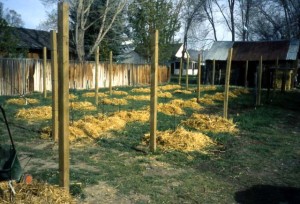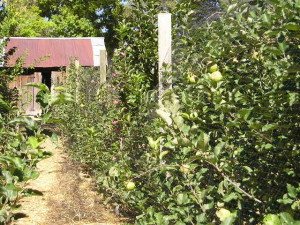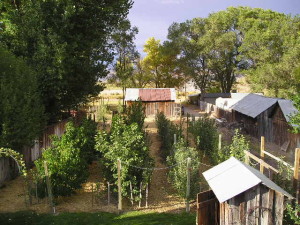HISTORY In the late nineties, I decided to plant 5 or 6 fruit trees that would grow in our backyard in northern Nevada. I started reading books on apples and fruit trees and sent off for catalogs. In the spring of 1999, I had narrowed my 5 to 6 trees down to 20 must-have varieties of apples and about a dozen stone fruits.
That year, with the initial planting done, I went back to the books and taught myself how to graft. Since then, I have grafted a few hundred trees each year since and expanded my collection to 100 varieties of apples.
VARIETIES Most of the varieties I am growing are antique apples such as Lady, Newton Pippin, and Esopus Spitzenburg. These and other antique apples have been propogated for many years because of their flavor and keeping qualities. I have several varieties of cider apples, including Wickson Crab, Brown Snout, and American Pippin. I also grow some modern varieties like Fuji and Honeycrisp.
CLIMATE Our area of northern Nevada is (allegedly) in USDA Zone 6. We are at 4500 ft elevation; annual rainfall averages 8 inches per year. Our last frost is usually before Memorial Day and our killing frost is in October, although tender plants like squash may get nipped as early as Labor Day. I prune my roses on April 15 and plant my tomatoes Memorial Day weekend
CULTURAL PRACTICES The orchard is 40 feet by 100 feet. In order to have as many varieties as possible, I have 5 rows, 100 feet long; the rows are 8 feet apart. Most of the trees are on Budagovski 9 rootstocks and are spaced 3 feet apart. The initial planting was trained as horizontal espaliers; later plantings are trained as fan espaliers, French axe, and dwarf pyramids. The trees are supported by a wire fence with strands starting at 2 feet high, then a foot apart up to 6 feet.
I use a drip irrigation system; the system waters twice a day every Wed and Sun for up to 1.5 hours each watering day during the summer. The hose is run on the lowest wire (about 2 feet off the ground); 2 gal per hour drippers are spaced 2 feet apart along the length of the hose. To retain moisture and for weed control, I mulch the entire orchard area with straw and/or composted horse manure in the spring and fall. Once a month during the summer, I use sprinklers to water overhead in the early morning.
OTHER FRUITS I have 4 cherry, 4 plum, and 3 peach/nectarine trees; all are semi-dwarfs trained as fan espaliers. I also grow currants, grapes, elderberries, raspberries, and hops.



Good afternoon! Can you tell me how to subscribe to your newsletter?
I see from this newsletter that you have honey in PV. Is that Palomino Valley? I live in Palomino Valley on Whiskey Springs and hope to start an orchard in the spring.
Thanks!
Nice orchard
Hi Michael
I have just recently become interested in “espalier “of apples. I have been looking locally for a suitable variety and size, with not much to choose from. I also live in northern NV. I am looking for a multi purpose apple for good for eating, cooking, juice, and sauce. I would be ok with a 1, or 2 year old tree, but can’t find anything that small locally. Any suggestions?
Hello. I keep coming across your name when looking into tree grafting classes. Do you have any classes planned?